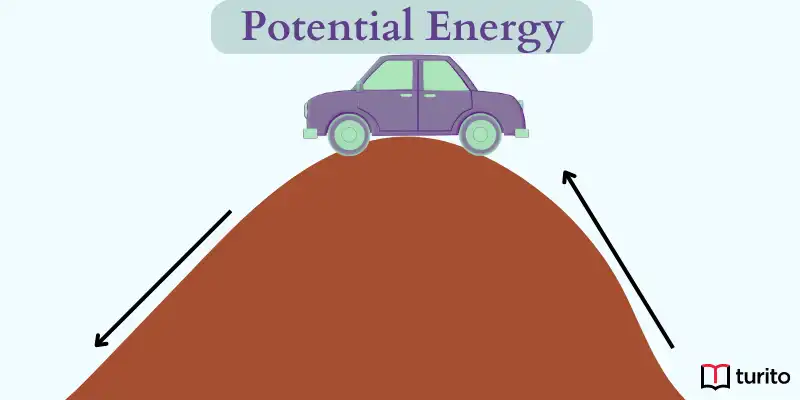Types of Potential Energy
There are two types of potential energy:
- Gravitational potential energy
- Elastic potential energy
Gravitational Potential Energy:
Let us consider a body of mass m, which is in the air and subjected to gravitational force; gravitational potential energy can be defined as the energy possessed by the body with respect to other bodies in the gravitational field.
Gravitational potential energy is given by
U = mgh
Where,
U= gravitational potential energy
m = mass
g = acceleration due to gravity
h = height at which the body experiences potential energy
Points to Be Remembered in Gravitational Potential Energy:
- Gravitational potential is an observer only in the gravitational field. If a gravitational field is absent, then there is no gravitational potential energy.
- It is the attraction and that attractive energy between two bodies in the gravitational field.
- U denotes gravitational potential energy.
Example:
Let us consider a football of mass 2 kg, which is being hit by a footballer in the air and the ball reached the height of 3 m, calculate the gravitational potential energy take g = 10 m/s.
Football of mass 2 kg will fall back to the ground as the ball is in the gravitational field as the attraction between the ball and the earth creates gravitational potential energy.
U= mgh
U = 2 x 10 x 3
U = 60 J
Elastic potential energy:
The energy possessed by anybody which has elastic property (spring), the potential energy created in the body before the release, or the relaxation of the body is called elastic potential energy.
The elastic potential energy is given by the magnitude of the force in the ideal spring.
F = kx
Where,
F = magnitude of the force
k = spring constant
x = displacement of the spring
The elastic potential energy is given by
U = ½ k x2
Points to be remembered in Elastic potential energy:
- The energy is possessed by the elastic material.
- The elastic potential energy is not independent of gravitational force.
- Elastic potential energy is denoted by F.
Example:
Let us consider a block that is held with a spring. The force applied on the spring is 5 N, and the spring’s displacement is 2 m. Find the spring constant and find elastic potential energy.
As spring is an elastic material, hence it possesses the elastic potential energy.
To find the sporing constant
F = kx
k = 5/2
k = 2.5
The elastic potential energy
U = ½ kx2
U = 5 J
Summary:
Gravitational Potential Energy:
Gravitational potential energy can be defined as the energy possessed by the body with respect to other bodies in the gravitational field.
Gravitational potential energy is given by
U = mgh
Where,
U= gravitational potential energy
m = mass
g = acceleration due to gravity
h = height at which body experiences potential energy
Elastic potential energy:
The energy is possessed by anybody that has elastic property (spring). The potential energy created in the body before the release, or the relaxation of the body is called elastic potential energy.
The elastic potential energy is given by the magnitude of the force in the ideal spring.
F = Kx

Related topics
Uniform and Non-Uniform Motion: Definition and Differences
Introduction Uniform and Non-Uniform Motion Moving objects move in many different ways. Some move fast and some slowly. Objects can also move in different kinds of paths. We shall categorize the motions done by objects into two categories based on the pattern of their pace of motion in this session. Explanation: Uniform Motion: Let us […]
Read More >>Weather Maps: Explanation, Reading, and Weather Fonts
Introduction: Evolution Weather Forecasting Weather forecasting is the use of science and technology to forecast atmospheric conditions for a certain place and period. Meteorology is used to forecast how the weather will behave in the future after collecting objective data on the atmosphere’s actual state in a certain area. Weather Tools Meteorologists use many tools […]
Read More >>Momentum vs Velocity: Expression and SI Units
Introduction: In our daily life, we make many observations, such as a fast bowler taking a run-up before bowling, a tennis player moving her racket backward before hitting the tennis ball and a batsman moving his bat backward before hitting the cricket ball. All these activities are performed to make the ball move with great […]
Read More >>Fossils: Formation, Importance, and Different Types
Introduction: Fossils are the preserved remains of plants and animals whose bodies were buried under ancient seas, lakes, and rivers in sediments such as sand and mud. Any preserved trace of life that is more than 10,000 years old is also considered a fossil. Soft body parts decompose quickly after death, but hard body parts […]
Read More >>Other topics











Comments: